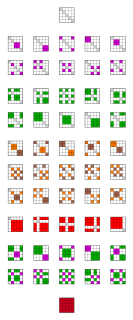Definitions
A tolerance relation on an algebraic structure is usually defined to be a reflexive symmetric relation on that is compatible with every operation in . A tolerance relation can also be seen as a cover of that satisfies certain conditions. The two definitions are equivalent, since for a fixed algebraic structure, the tolerance relations in the two definitions are in one-to-one correspondence. The tolerance relations on an algebraic structure form an algebraic lattice under inclusion. Since every congruence relation is a tolerance relation, the congruence lattice is a subset of the tolerance lattice , but is not necessarily a sublattice of . [4]
As binary relations
A tolerance relation on an algebraic structure is a binary relation on that satisfies the following conditions.
- (Reflexivity) for all
- (Symmetry) if then for all
- (Compatibility) for each -ary operation and , if for each then . That is, the set is a subalgebra of the direct product of two .
A congruence relation is a tolerance relation that is also transitive.
As covers
A tolerance relation on an algebraic structure is a cover of that satisfies the following three conditions. [5] : 307, Theorem 3
- For every and , if , then .
- In particular, no two distinct elements of are comparable. (To see this, take .)
- For every , if is not contained in any set in , then there is a two-element subset such that is not contained in any set in .
- For every -ary and , there is a such that . (Such a need not be unique.)
Every partition of satisfies the first two conditions, but not conversely. A congruence relation is a tolerance relation that also forms a set partition.
Equivalence of the two definitions
Let be a tolerance binary relation on an algebraic structure . Let be the family of maximal subsets such that for every . Using graph theoretical terms, is the set of all maximal cliques of the graph . If is a congruence relation, is just the quotient set of equivalence classes. Then is a cover of and satisfies all the three conditions in the cover definition. (The last condition is shown using Zorn's lemma.) Conversely, let be a cover of and suppose that forms a tolerance on . Consider a binary relation on for which if and only if for some . Then is a tolerance on as a binary relation. The map is a one-to-one correspondence between the tolerances as binary relations and as covers whose inverse is . Therefore, the two definitions are equivalent. A tolerance is transitive as a binary relation if and only if it is a partition as a cover. Thus the two characterizations of congruence relations also agree.
Quotient algebras over tolerance relations
Let be an algebraic structure and let be a tolerance relation on . Suppose that, for each -ary operation and , there is a unique such that
Then this provides a natural definition of the quotient algebra
of over . In the case of congruence relations, the uniqueness condition always holds true and the quotient algebra defined here coincides with the usual one.
A main difference from congruence relations is that for a tolerance relation the uniqueness condition may fail, and even if it does not, the quotient algebra may not inherit the identities defining the variety that belongs to, so that the quotient algebra may fail to be a member of the variety again. Therefore, for a variety of algebraic structures, we may consider the following two conditions. [4]
- (Tolerance factorability) for any and any tolerance relation on , the uniqueness condition is true, so that the quotient algebra is defined.
- (Strong tolerance factorability) for any and any tolerance relation on , the uniqueness condition is true, and .
Every strongly tolerance factorable variety is tolerance factorable, but not vice versa.

































































